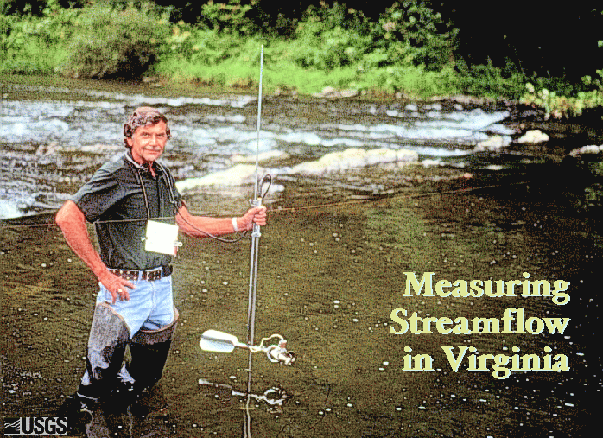
Measuring Streamflow in Virginia
Open-File Report 95–713 (revised, 1999)
Prepared in cooperation with the Virginia Department of Environmental Quality–Water Division
By Roger M. Moberg and Karen C. Rice,
U.S. Geological Survey,
and Eugene D. Powell,
Virginia Department of Environmental Quality
Introduction
The U.S. Geological Survey (USGS), U.S. Department of the Interior,
is the Nation's largest Earth-science information agency. Among its many
responsibilities, such as map making and providing information on
earthquakes and other natural hazards, the USGS provides information
on the Nation's water resources. The USGS has collected and analyzed
hydrologic (water-related) information for more than 100 years. In 1889, the first streamflow-gaging station (a site where regular observations of streamflow data are collected) operated in the United States by the USGS was established on the Rio Grande near Embudo, New Mexico. As the
need for streamflow data increased, the USGS's streamflow-gaging program
has grown to include more than 7,000 continuous-record streamflow-gaging stations. More than 90 percent of these stations are operated with at least partial support from State, local, and other Federal agencies.
In Virginia, the Department of Environmental Quality (DEQ) is a major cooperator in the streamflow-gaging program, which consists of 152 continuous-record streamflow-gaging stations located throughout the State (fig. 1). The USGS and DEQ cooperate to publish the annual USGS State data report, "Water Resources Data-Virginia;" this two-volume publication includes streamflow data collected at the 152 streamflow-gaging stations, chemical data collected at more than 24 streamflow-gaging stations, and ground-water data collected from more than 338 wells.
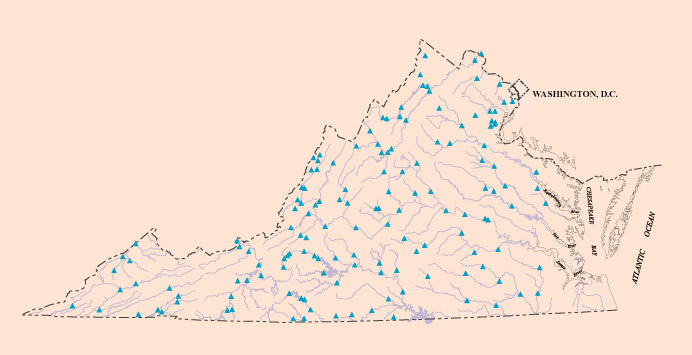 |
Figure 1.
Locations of the 152 continuous-record streamflow-gaging stations in Virginia in 1998,
jointly operated by the U.S. Geological Survey and the Virginia Department of Environmental Quality. |
Why Does the USGS Measure Streamflow?
Streamflow data collected at streamflow-gaging stations across the country
are used extensively by the general public, Federal, State and local agencies,
and utility companies to make a wide variety of decisions. For example, a
sportsman may want to know whether river conditions are safe for a
river-rafting trip. The National Weather Service uses data from
streamflow-gaging stations to forecast flow on major rivers and streams,
especially flood flows (fig. 2). The U.S. Army Corps of Engineers and utility
companies use streamflow data for the daily management and operation of
numerous reservoirs and powerplants. The hydrologic information helps them determine when to withdraw water from a reservoir, especially during droughts.
The Virginia Department of Transportation uses streamflow data to design
bridges and roads. Streamflow data also are used by regulatory agencies, such
as the DEQ, to establish permits for the discharge of treated wastewater and
water use. The hydrologic information also is critical to water managers,
policy makers, scientists, and other members of the general public for
characterizing and understanding the water-quality conditions of our Nation's
streams, lakes, reservoirs, and estuaries. Streamflow data ultimately aid in
preserving, managing, and improving the use of our Nation's water resources.
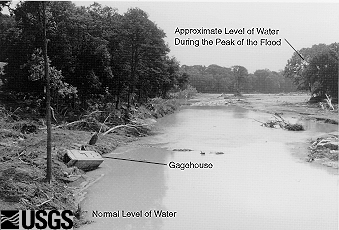 |
Figure 2.
The Rapidan River in north-central Virginia
after the flood of June 1995. The concrete
gagehouse was broken by the force of the water,
which was 30 feet higher during the peak of the
flood (approximately 100,000 cubic feet per
second) than its normal level (139 cubic feet per
second) as shown in the photograph. |
How Does the USGS Measure Streamflow?
In order to measure streamflow, the depth and width of a stream and the
velocity (speed at w
hich water travels) need to be determined. The area (depth
multiplied by the width) multiplied by the velocity gives the discharge
(volume of water per unit of time) that passes a given location along a
stream. A discharge measurement, then, is a measurement of the volume of
water that passes a given stream cross section (total width of the stream)
within a given period of time.
Three types of discharge measurements are made by USGS and DEQ technicians on a stream: wading, suspension, and boat. A wading measurement is made by a technician who walks into the water on foot (see first photograph). A suspension measurement is made by a technician from a bridge (bridge measurement) or a cable (cableway measurement) that crosses the stream (fig. 3). A boat measurement is made by a technician in a boat when a bridge or cable is not available.
The wading measurement is the most common type of discharge measurement and requires the use of a current meter, wading rod, earphones, stopwatch, tagline, and notepad (fig. 4). To make a wading measurement, the technician divides the cross section into small units,called "stations." At each station, the technician measures the depth of the stream, the width of the station, and the velocity of the water by use of the current meter. A current meter, similar to a wind-speed measuring device, consists of a wheel with six rotating cups that slides up and down the wading rod. The technician records the number of revolutions of the current meter and the elapsed time on a notepad for each station; the greater the number of revolutions of the current meter, the greater the velocity of the water. These records are used to calculate the velocity of the water at each station. The technician then multiplies the depth of the stream, in feet, by the distance between each station, in feet, by the velocity of the water at each station, in feet per second. The product of the three numbers gives the discharge for that station, in cubic feet per second. The discharges calculated for all of the stations are then summed to get the total discharge for the stream at the cross section.
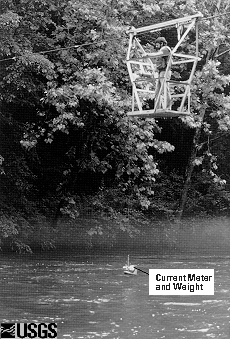 |
Figure 3.
Discharge measurement being made from a cable suspended
above the stream. Cableway measurements are made when
the stream is too wide or too deep to make a wading
measurement. |
Continuous measurements of water level of the stream are made inside a gagehouse. A typical gagehouse is a concrete structure located on the bank of a stream, with a pipe extending into the stream (fig. 4).
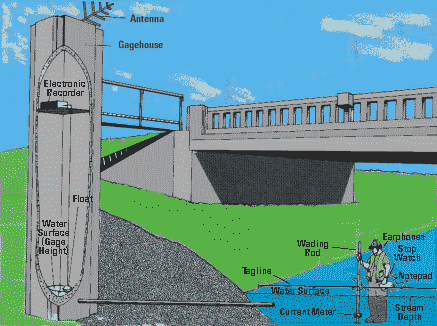 |
Figure 4.
Diagram of a technician making a
wading measurement, and a gagehouse.
The wading rod is graduated in tenths
of a foot and is used to measure the
depth of the stream. Earphones are
used to hear the revolutions of the
current meter. The stopwatch is used
to measure an interval of time during
which the revolutions of the current
meter are counted. A tagline is like a
measuring tape and is used to measure
the distance from streambank to
streambank. The antenna on top of the
gagehouse transmits the gage-height
records to a satellite; the data are
then relayed back to earth, providing
real-time data.
|
The pipe allows water from the stream to enter the gagehouse so that the gage height (level of the water surface in the gagehouse) is equal to that of the stream. Inside the gagehouse, electronic devices record the gage height, usually at 15-minute intervals. These gage-height records are retrieved routinely when a technician visits the gagehouse. The gage-height records are then entered into a computer and are available for use only after the data have been processed. At other gagehouses, the most recently recorded gage height can be retrieved by dialing a telephone number. At some gagehouses, the gage-height records are transmitted to a satellite and then relayed back to earth to a computer, providing real-time (immediately available) data. (Provisional real-time streamflow data from some gagehouses in Virginia can be found by accessing the Virginia District Home Page at
Real-time
Streamflow Conditions).
The continuous gage-height records along with the discharge measurements made by the technician are used to create a rating table (a chart showing the relation of gage height to discharge) for a stream. Rating tables are used to estimate the discharge of the stream by using only the gage-height records collected from the gagehouse. The advantage of having a rating table for a stream is that once the gage height is known, the discharge can be inferred without having to go to the stream and make a discharge measurement. Over time, however, the relation between the gage height and discharge can change, requiring periodic discharge measurements to be made to redefine that relation.
The Virginia Department of Environmental Quality:
Mission Statement
The mission of Virginia's DEQ is to protect the environment of Virginia in order to promote the health and well-being of her citizens. DEQ is a
regulatory agency in which the Water Division is tasked with protecting
Virginia's water resources. Critical to this task is an understanding of the
hydrology of Virginia both above and below ground. The surface-water hydrology
of the State is monitored through the network of stream gages DEQ operates
cooperatively with the USGS. The data collected at the gaging stations are
used to help evaluate the quality of Virginia's rivers.
Mission of the Water Resources Division
The U.S. Geological Survey has the principal responsibility within the Federal Government to provide the hydrologic information and understanding
needed by others to achieve the best use and management of the Nation's water resources. To accomplish this mission, the Water Resources
Division, in cooperation with State, local, and other Federal agencies,
- Systematically collects and analyzes data to evaluate the quantity, quality, and use of the Nation's water resources and provides results of these investigations to the public.
- Conducts water-resources appraisals describing the occurrence, availability, and physical, chemical, and biological characteristics of surface and ground water.
- Conducts basic and problem-oriented hydrologic and related research that aids in alleviating water resources problems and provides an understanding of hydrologic systems sufficient to predict their response to natural or human-caused stress.
- Coordinates the activities of Federal agencies in the acquisition of water resources data for streams, lakes, reservoirs, estuaries, and ground water.
- Provides scientific and technical assistance in hydrologic fields to other Federal, State, and local agencies, to licensees of the Federal Energy Regulatory Commission, and to international agencies on behalf of the Department of State.
- Administers the State Water Resources Research Institutes Program and the National Water Resources Research Grants Program.
For more information, contact any of the following:
Office Director
Department of Environmental Quality
900 Natural Resources Drive
Suite 1060
Charlottesville, Virginia 22903
Eugene Powell, Environmental Engineer
edpowell@deq.state.va.us
Phone (804) 293-3031
Fax (804) 977-6751
|
 |
District Chief
U.S. Geological Survey
1730 East Parham Road
Richmond, Virginia 23228
dc_va@usgs.gov
Phone: (804) 261-2600
Fax (804) 261-2659
For more information on all USGS reports and products (including maps, images,
and computerized data), call 1-888-ASK-USGS.
The president of the American Society of Civil Engineers states
"...consulting engineers in the private sector, in addition to engineers
working at all levels of government, rely on the unbiased and objective
scientific information and data provided by [the USGS]."
Contact: GS-W-VArmd_webmaster@usgs.gov
U.S. Department of Interior,
U.S. Geological Survey
Privacy Statement
Disclaimer
URL://va.water.usgs.gov/online_pubs/OFR95-713.html
Last modified: 03/16/02 09:39:33 AM
